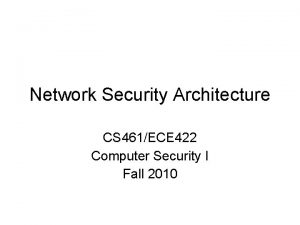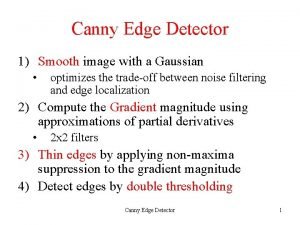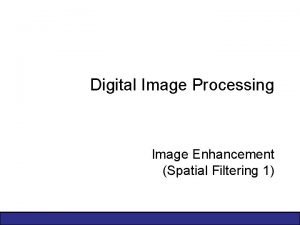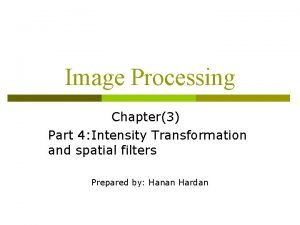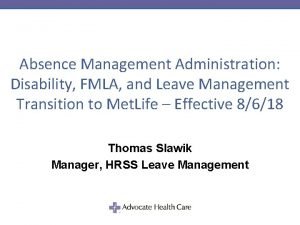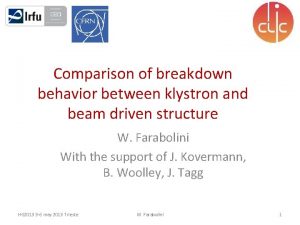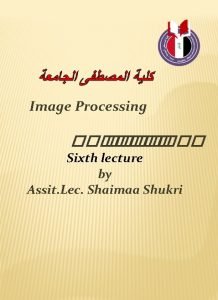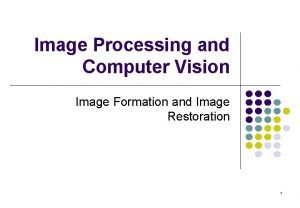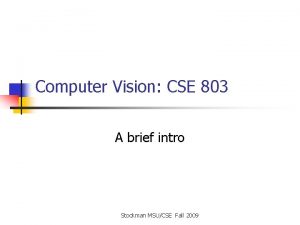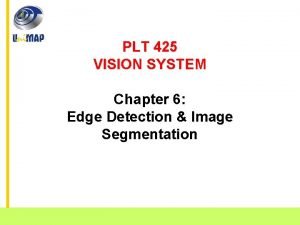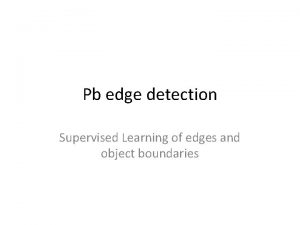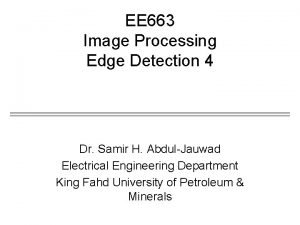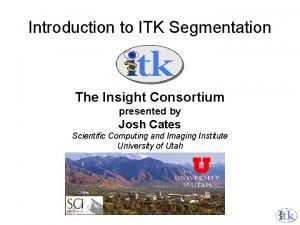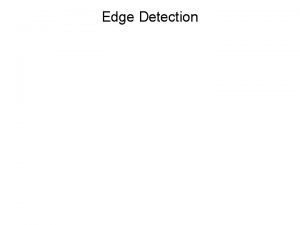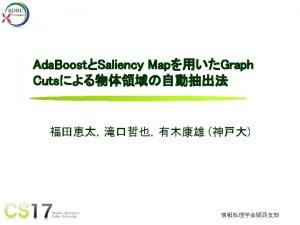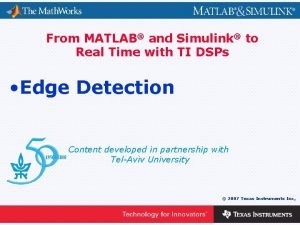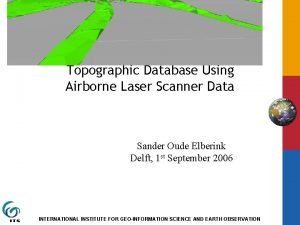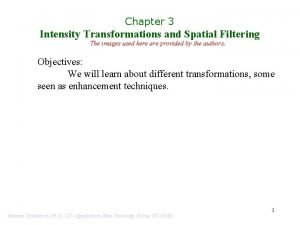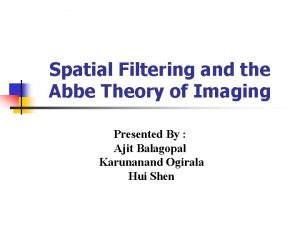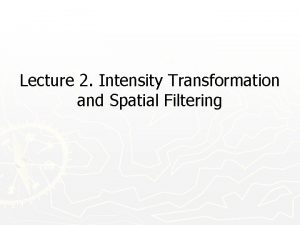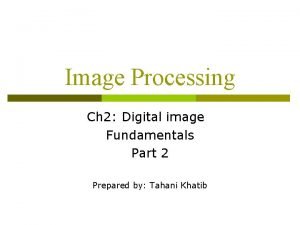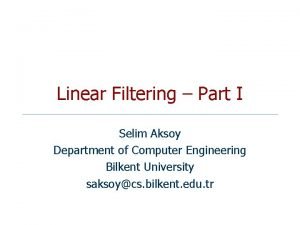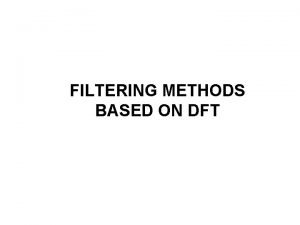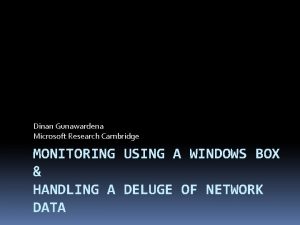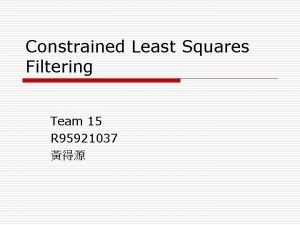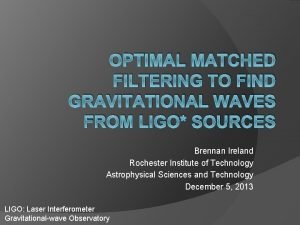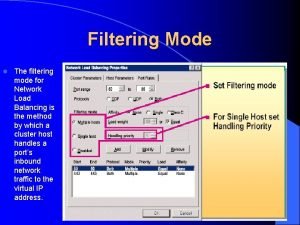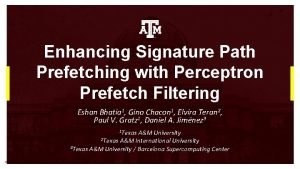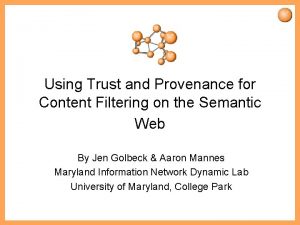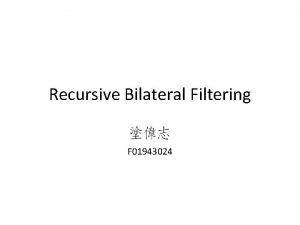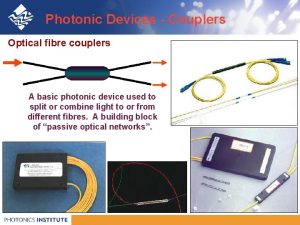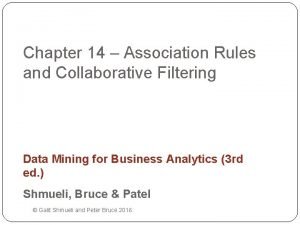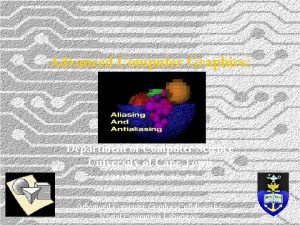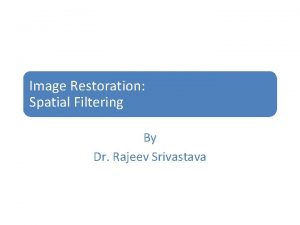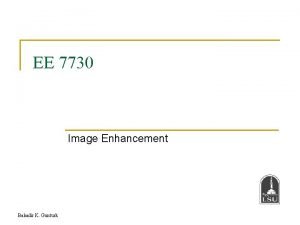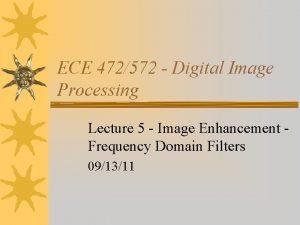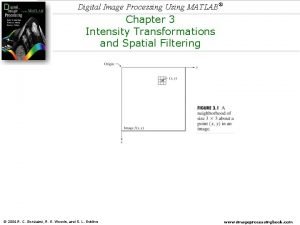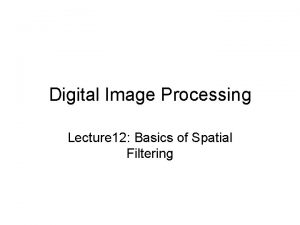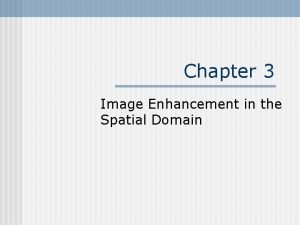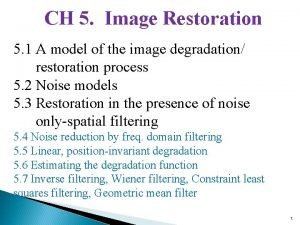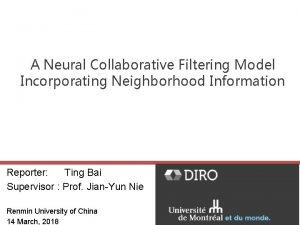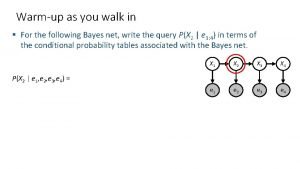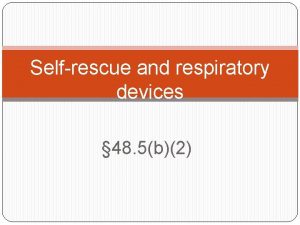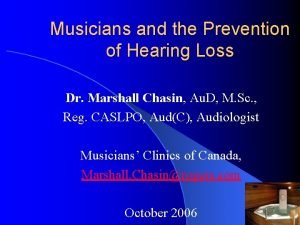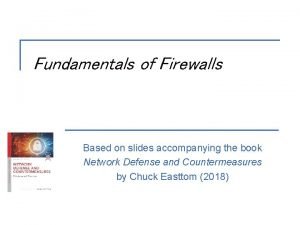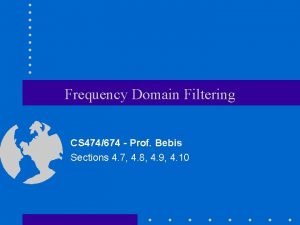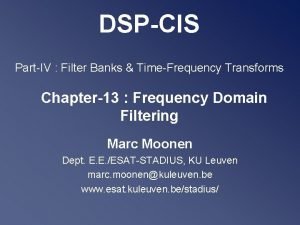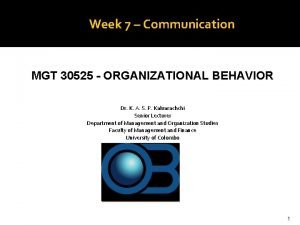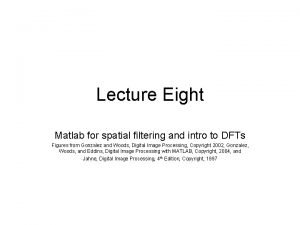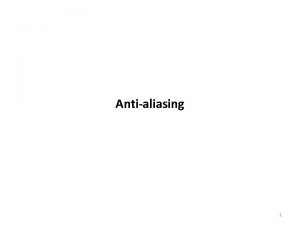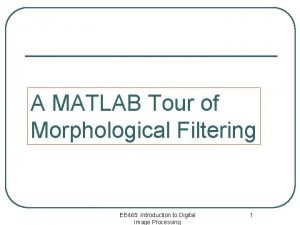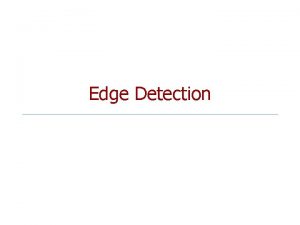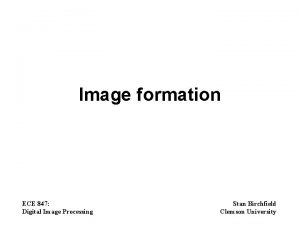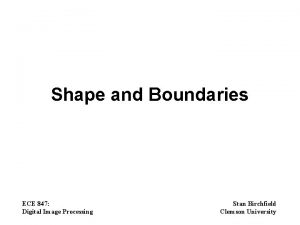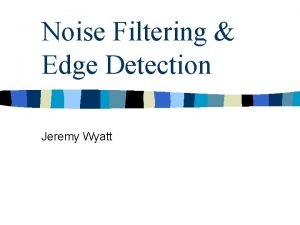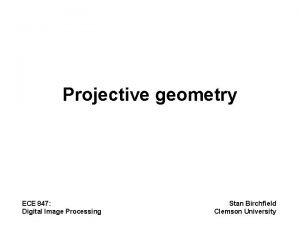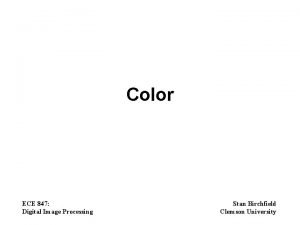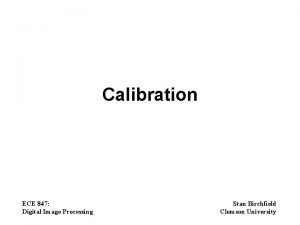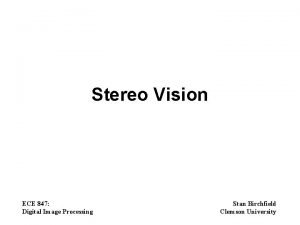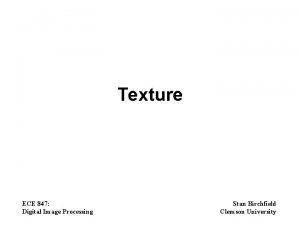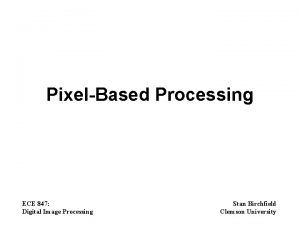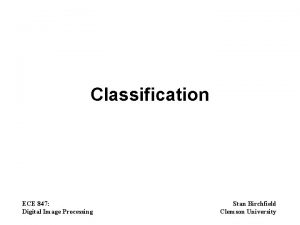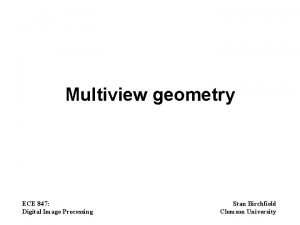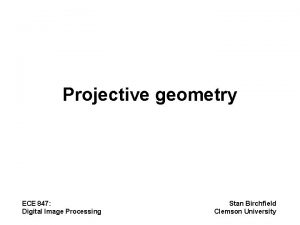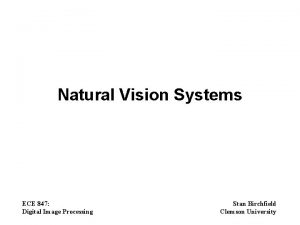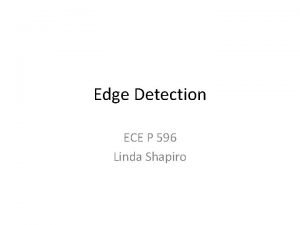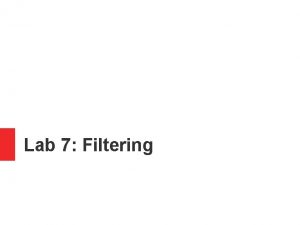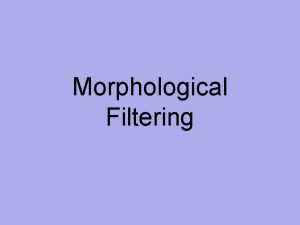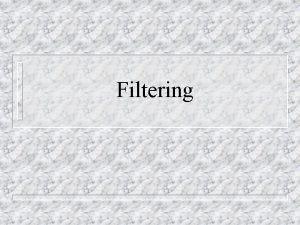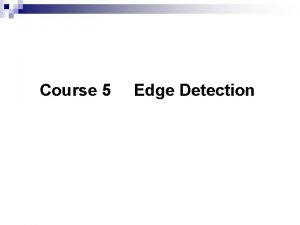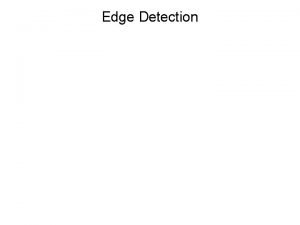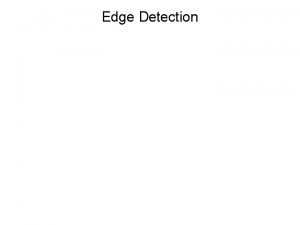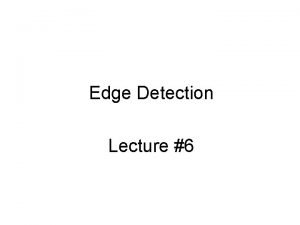Image Filtering and Edge Detection ECE 847 Digital
















![Signal borders • Zero extension: [1 5 6 7] * [1/3 1/3] is the Signal borders • Zero extension: [1 5 6 7] * [1/3 1/3] is the](https://slidetodoc.com/presentation_image_h/2ab1f18a70793782bf737eca031d988b/image-17.jpg)















![Example • Kernel: g[0] g[1] g[2] • Mean: • Variance: 2 1 1 0 Example • Kernel: g[0] g[1] g[2] • Mean: • Variance: 2 1 1 0](https://slidetodoc.com/presentation_image_h/2ab1f18a70793782bf737eca031d988b/image-33.jpg)




































































![Creating 3 x 1 kernels • Sample Gaussian: [a b a] • Normalize by Creating 3 x 1 kernels • Sample Gaussian: [a b a] • Normalize by](https://slidetodoc.com/presentation_image_h/2ab1f18a70793782bf737eca031d988b/image-102.jpg)
![Creating 3 x 1 kernels • Sample Gaussian derivative: [a 0 -a] • Convolution Creating 3 x 1 kernels • Sample Gaussian derivative: [a 0 -a] • Convolution](https://slidetodoc.com/presentation_image_h/2ab1f18a70793782bf737eca031d988b/image-103.jpg)
![Creating 3 x 1 kernels • Sample Gaussian 2 nd derivative: [a -b a] Creating 3 x 1 kernels • Sample Gaussian 2 nd derivative: [a -b a]](https://slidetodoc.com/presentation_image_h/2ab1f18a70793782bf737eca031d988b/image-104.jpg)

- Slides: 105

Image Filtering and Edge Detection ECE 847: Digital Image Processing Stan Birchfield Clemson University

Motivation Two closely related problems: blur (to remove noise) differentiate (to highlight details) S. Birchfield, Clemson Univ. , ECE 847, http: //www. ces. clemson. edu/~stb/ece 847

Motivation Two closely related problems: blur (to remove noise) differentiate (to highlight details) Underlying math is the same! S. Birchfield, Clemson Univ. , ECE 847, http: //www. ces. clemson. edu/~stb/ece 847

Recall: Types of image transformations • Graylevel transforms I’(x, y) f( I(x, y) ) (arithmetic, logical, thresholding, histogram equalization, …) • Geometric transforms I’(x, y) f( I(x’, y’) ) (flip, flop, rotate, scale, …) • Area-based transforms I’(x, y) f( I(x, y), I(x+1, y+1), … ) filtering (morphological operators, convolution) • Global transforms I’(x, y) f( I(x’, y’), x’, y’ ) (Fourier transform, wavelet transform) } A S. Birchfield, Clemson Univ. , ECE 847, http: //www. ces. clemson. edu/~stb/ece 847

Outline • • • Convolution Gaussian convolution kernels Smoothing an image Differentiating an image Canny edge detection Laplacian of Gaussian

Linear time-invariant (LTI) systems • System produces output from input: • Two properties of linear systems: 1. homogeneity (or scaling): Scaling of input propagates to output 2. superposition (or additivity): Sum of two inputs yields sum of two outputs • Time-invariant (or shift-invariant): Output does not depend upon absolute time (shift) of input S. Birchfield, Clemson Univ. , ECE 847, http: //www. ces. clemson. edu/~stb/ece 847

System examples • Linear time invariant: y(t) = 5 x(t) y(t) = x(t-1) + 2 x(t) + x(t+1) • Linear time varying: y(t) = tx(t) • Nonlinear: y(t) = cos( x(t) ) S. Birchfield, Clemson Univ. , ECE 847, http: //www. ces. clemson. edu/~stb/ece 847

Question • Is this system linear? y(t) = mx(t) + b S. Birchfield, Clemson Univ. , ECE 847, http: //www. ces. clemson. edu/~stb/ece 847

Question • Is this system linear? y(t) = mx(t) + b • No, not if b ≠ 0, because scaling the input does not scale the output: m∙ax(t) + b = amx(t) + b ≠ ay(t) • Technically, this is called an affine system • Ironic that a linear equation does not describe a linear system S. Birchfield, Clemson Univ. , ECE 847, http: //www. ces. clemson. edu/~stb/ece 847

LTI systems are described by convolution • Continuous (Notation is usually *, but we want to avoid confusion with multiplication) • Discrete Note: Convolution is commutative S. Birchfield, Clemson Univ. , ECE 847, http: //www. ces. clemson. edu/~stb/ece 847

Relationship to cross-correlation • Continuous complex conjugate no flip • Discrete Note: Convolution and cross-correlation are identical when the signal is real and the kernel is symmetric S. Birchfield, Clemson Univ. , ECE 847, http: //www. ces. clemson. edu/~stb/ece 847

Convolution with discrete, finite duration signals • width and half-width of kernel: (if w is odd) • convolution assumes (if w is odd) • examples: (underline indicates origin) S. Birchfield, Clemson Univ. , ECE 847, http: //www. ces. clemson. edu/~stb/ece 847

Convolution implementation (1 D) • In memory, indices must be non-negative • So shift kernel by : • Algorithm: – Flip g (not needed in practice) – For each x • Align g so that center is at x • Sum the products S. Birchfield, Clemson Univ. , ECE 847, http: //www. ces. clemson. edu/~stb/ece 847

Kernel flipping • In practice, no need to flip g – If g is symmetric, then same result [ 1 2 1 ] – If g is antisymmetric, then just sign change [ -1 0 1 ] • For real images and symmetric kernels, convolution = cross-correlation S. Birchfield, Clemson Univ. , ECE 847, http: //www. ces. clemson. edu/~stb/ece 847

Convolution implementation (1 D) • Algorithm: • Note: – Convolution cannot be done “in place” – Output must be separate from input, to avoid corrupting computation S. Birchfield, Clemson Univ. , ECE 847, http: //www. ces. clemson. edu/~stb/ece 847

1 D convolution example • Given the 1 D signal • Suppose we want to compute the average of each pixel and its 2 neighbors • Solution: slide kernel across signal, elementwise multiplication and sum : • Result: • This is known as shift-multiply-add S. Birchfield, Clemson Univ. , ECE 847, http: //www. ces. clemson. edu/~stb/ece 847
![Signal borders Zero extension 1 5 6 7 13 13 is the Signal borders • Zero extension: [1 5 6 7] * [1/3 1/3] is the](https://slidetodoc.com/presentation_image_h/2ab1f18a70793782bf737eca031d988b/image-17.jpg)
Signal borders • Zero extension: [1 5 6 7] * [1/3 1/3] is the same as [… 0 1 5 6 7 0 …] * [… 0 1 1 1 0 …]/3 • Result: [… 0 0. 33 2 4 6 4. 33 2. 33 0 0 0 …] • If signal has length n and kernel has length w, then result has length n+w-1 • But we adopt convention of cropping output to same size as input S. Birchfield, Clemson Univ. , ECE 847, http: //www. ces. clemson. edu/~stb/ece 847

(replication/ reflection) 8 ¼ 1 D convolution example kernel image 8 ½ 24 48 32 16 16 ¼ ½ ½ ¼ ¼ ¼(8) + ½(24) + ¼(48) = 26 = ¼ ¼ ¼(8) + ½(8) + ¼(24) = 12 (flipped) ¼ * ½ ¼ 12 26 38 32 20 ¼ ½ ¼(48) + ½(32) + ¼(16) = 32 ¼ ¼(32) + ½(16) + ¼(16) = 20 S. Birchfield, Clemson Univ. , ECE 847, http: //www. ces. clemson. edu/~stb/ece 847

Convolution in 2 D image convolution kernel (shifted by and ) Algorithm: • kernel is a little image containing weights • Algorithm: – Flip g (horizontally and vertically – not important in practice) – For each (x, y) • Align g so that center is at (x, y) • Sum the products S. Birchfield, Clemson Univ. , ECE 847, http: //www. ces. clemson. edu/~stb/ece 847

Convolution implementation (2 D) • Algorithm: • Again, note that convolution cannot be done “in place” S. Birchfield, Clemson Univ. , ECE 847, http: //www. ces. clemson. edu/~stb/ece 847

Convolution as matrix multiplication • Equivalent to multiplying by Toeplitz matrix (ignoring border effects): extend by replication • Applicable to any dimension S. Birchfield, Clemson Univ. , ECE 847, http: //www. ces. clemson. edu/~stb/ece 847

Convolution as Fourier multiplication • Convolution in spatial domain is multiplication in frequency domain • Computationally efficient only when kernel is large • Equivalent to circular convolution (signals are treated as periodic) S. Birchfield, Clemson Univ. , ECE 847, http: //www. ces. clemson. edu/~stb/ece 847

Outline • • • Convolution Gaussian convolution kernels Smoothing an image Differentiating an image Canny edge detection Laplacian of Gaussian

Two types of convolution kernels Smoothing Differentiating (Smoothing a constant function should not change it) (Differentiating a constant function should return 0) Example: (1/3) * [1 1 1] Example: (1/2) * [-1 0 1] Lowpass filter (Gaussian) Highpass filter (derivative of Gaussian) … also bandpass filters (Laplacian of Gaussian) S. Birchfield, Clemson Univ. , ECE 847, http: //www. ces. clemson. edu/~stb/ece 847

Box filter Simplest smoothing kernel is the box filter: 1/n 0 (n=1) (n=3) (n=5) Odd length avoids undesirable shifting of signal S. Birchfield, Clemson Univ. , ECE 847, http: //www. ces. clemson. edu/~stb/ece 847

Gaussian kernel • Gaussian function is “bell curve”: • Performs weighted average of neighboring values mean (center) standard deviation (width) variance Normalization factor ensures PDF:

Gaussian provides weighted average of neighbors Why is Gaussian so important? • completely described by 1 st and 2 nd order statistics • central limit theorem • localized in space and frequency • convolution of two Gaussians is Gaussian m=m 1+m 2 and s 2=s 12+s 22 • separable (efficient) S. Birchfield, Clemson Univ. , ECE 847, http: //www. ces. clemson. edu/~stb/ece 847

Repeated averaging Repeated convolution with box filter yields convolution with Gaussian (from Central Limit Theorem): These are the odd rows of the binomial (Pascal’s) triangle: (2 k+1)th row approximates Gaussian with s 2=k/2 k=1, s 2=0. 5, s=0. 7 k=2, s 2=1, s=1 Note that scale factor is power of two (makes normalization fast because division is just bit shift) S. Birchfield, Clemson Univ. , ECE 847, http: //www. ces. clemson. edu/~stb/ece 847

Repeated averaging (cont. ) Trinomial triangle also yields Gaussian approximations: kth row approximates Gaussian with s 2=2 k/3 Example: In general, n repeated convolutions with s 2 Gaussian approximates single convolution with ns 2 Gaussian S. Birchfield, Clemson Univ. , ECE 847, http: //www. ces. clemson. edu/~stb/ece 847

Computing the variance of a smoothing kernel • Set of values: • Mean is • Variance is deviation from mean:

Computing the variance of a smoothing kernel • Kernel is a sequence of values: • Is this the mean? • Is this the variance? No, because a sequence is not a set (order matters)

Computing the variance of a smoothing kernel • Kernel is a sequence of values: • Mean: • Variance: Note: These are weighted averages, with weights g(i)
![Example Kernel g0 g1 g2 Mean Variance 2 1 1 0 Example • Kernel: g[0] g[1] g[2] • Mean: • Variance: 2 1 1 0](https://slidetodoc.com/presentation_image_h/2ab1f18a70793782bf737eca031d988b/image-33.jpg)
Example • Kernel: g[0] g[1] g[2] • Mean: • Variance: 2 1 1 0 1 2 Note:

Building a Gaussian kernel • How to build Gaussian kernel with arbitrary s? • Sample continuous Gaussian continuous normalization f=2. 5 is reasonable, to capture ± 2. 5 s, because discrete version approximately captures But we want to ensure discrete normalization S. Birchfield, Clemson Univ. , ECE 847, http: //www. ces. clemson. edu/~stb/ece 847

Building a Gaussian kernel

Choosing number of samples

Common Gaussian kernels (The subscript is s 2. )

Sampling effects • Resulting discrete function will not have the same s as original continuous function • Example: – Sample s=1 (s 2=1) (0. 4026) * [0. 1353 0. 6065 1. 0000 0. 6065 0. 1353] – Resulting discrete kernel has s 2=(0. 4026) * 2 * [(0. 1353)*(22)+(0. 6065)*(12)] = 0. 92 • Another example: – Sample s=1. 08 (s 2=1. 17) (0. 3755) * [0. 1800 0. 6514 1. 0000 0. 6514 0. 1800] approx (1/16) [ 1 4 6 4 1 ] – Resulting discrete kernel has s=1 S. Birchfield, Clemson Univ. , ECE 847, http: //www. ces. clemson. edu/~stb/ece 847

(Some say) three samples is not enough to capture Gaussian Spatial domain: Capture 98. 76% of the area with ± 2. 5 s (continuous) Frequency domain: kernel width = 2*(halfwidth)+1 Capture 98. 76% of the area with (Note: sampling at 1 pixel intervals cutoff frequency is 2 p(0. 5) = ±p) [Trucco and Verri, p. 60] But in practice three samples is common S. Birchfield, Clemson Univ. , ECE 847, http: //www. ces. clemson. edu/~stb/ece 847

What is the best 3 x 1 Gaussian kernel? Spatial domain: Capture some percentage of the area with ±as w ≥ 2 as Frequency domain: kernel width = 2*(halfwidth)+1 Capture the same percentage with 2 a/s ≤ 2 p Combining these yields: s= 0. 69 a = 2. 17 97% of Gaussian is captured (not bad!) S. Birchfield, Clemson Univ. , ECE 847, http: //www. ces. clemson. edu/~stb/ece 847

Binomial triangle Gaussians are too wide Recall that the binomial (Pascal’s) triangle is an easy way to construct a Gaussian of width (2 k+1) and variance s 2=k/2 Recall that to capture 98. 76% of the area, we want For s = 1. 0, width is perfect, but for larger s the kernel is too wide What are the implications for repeated averaging? S. Birchfield, Clemson Univ. , ECE 847, http: //www. ces. clemson. edu/~stb/ece 847

Outline • • • Convolution Gaussian convolution kernels Smoothing an image Differentiating an image Canny edge detection Laplacian of Gaussian

Separability Can always construct 2 D kernel by convolving 1 D kernels: Some 2 D kernels can be decomposed into 1 D kernels: A 2 D kernel is separable iff all rows / columns are linearly dependent S. Birchfield, Clemson Univ. , ECE 847, http: //www. ces. clemson. edu/~stb/ece 847

Separability Separable convolution is less expensive: O(n^2) operations O(2 n) operations Allowed because convolution is associative: Convolve with two 1 D kernels instead of one 2 D kernel S. Birchfield, Clemson Univ. , ECE 847, http: //www. ces. clemson. edu/~stb/ece 847

Separability of Gaussian 2 D Gaussian (isotropic): Convolution with 2 D Gaussian is same as convolution with two 1 D Gaussians (horizontal and vertical): S. Birchfield, Clemson Univ. , ECE 847, http: //www. ces. clemson. edu/~stb/ece 847

Separable convolution horizontal then input vertical (or vice versa) output temporary Remember: Do not try to perform convolution in place! S. Birchfield, Clemson Univ. , ECE 847, http: //www. ces. clemson. edu/~stb/ece 847

Separable convolution

Smoothing with a Gaussian from http: //www-static. cc. gatech. edu/classes/AY 2007/cs 4495_fall/html/materials. html

Effects of different sigmas from http: //www-static. cc. gatech. edu/classes/AY 2007/cs 4495_fall/html/materials. html

Gaussian pyramid smooth downsample s Shannon’s sampling theorem: After smoothing, many pixels are redundant. Therefore, we can discard them (by downsampling) without losing information from http: //www-static. cc. gatech. edu/classes/AY 2007/cs 4495_fall/html/materials. html

Other linear filters • Finite impulse response (FIR): (This is just convolution) • Infinite impulse response (IIR): • Advantages of IIR: – Recursive computation can be performed in place (unlike convolution) – Can be faster for large s S. Birchfield, Clemson Univ. , ECE 847, http: //www. ces. clemson. edu/~stb/ece 847

Nonlinear filters Median filter: Replace pixel with median of surrounding n x n region Good for impulse noise (salt-andpepper noise) image impulse noise mean filtering median filtering What is mean filter good for? additive Gaussian noise S. Birchfield, Clemson Univ. , ECE 847, http: //www. ces. clemson. edu/~stb/ece 847

Grayscale morphology • Grayscale erosion – Similar to convolution, but replace sum with min and replace multiplication with subtraction – Reduces bright details • Grayscale dilation – Similar to convolution, but replace sum with max and replace multiplication with addition – Reduces dark details S. Birchfield, Clemson Univ. , ECE 847, http: //www. ces. clemson. edu/~stb/ece 847

Outline • • • Convolution Gaussian convolution kernels Smoothing an image Differentiating an image Canny edge detection Laplacian of Gaussian

Edge detection • What is an edge? • No precise definition (like many problems in computer vision) • Basically a place where the intensity changes significantly • Four types: step edge line edge roof edge ramp edge • We will concentrate on step edges (the most common) S. Birchfield, Clemson Univ. , ECE 847, http: //www. ces. clemson. edu/~stb/ece 847

The importance of intensity edges from Walther et al. , Simple line drawings suffice for functional MRI decoding of natural scene categories, PNAS 2011 Much information is retained by the edges S. Birchfield, Clemson Univ. , ECE 847, http: //www. ces. clemson. edu/~stb/ece 847

The importance of intensity edges from Walther et al. , Simple line drawings suffice for functional MRI decoding of natural scene categories, PNAS 2011 Much information is retained by the edges S. Birchfield, Clemson Univ. , ECE 847, http: //www. ces. clemson. edu/~stb/ece 847

Finite differences Simplest differentiating kernel is finite differences: Forward difference Backward difference Example: (Don’t forget to flip kernel before convolving) S. Birchfield, Clemson Univ. , ECE 847, http: //www. ces. clemson. edu/~stb/ece 847

Central differences To avoid undesirable shift, use central difference kernel: Central difference Example: Note: Result has the same basic shape S. Birchfield, Clemson Univ. , ECE 847, http: //www. ces. clemson. edu/~stb/ece 847

What is central difference doing? Central difference seems strange b/c it completely ignores the pixel: same result! But it averages the two slopes: f x-1 (backward diff) x x+1 (forward diff) S. Birchfield, Clemson Univ. , ECE 847, http: //www. ces. clemson. edu/~stb/ece 847

Smoothed differentiation Central difference kernel is a smoothed version of forward / backward difference: Smoothing, then differentiating, is the same as convolving with a smoothed differentiation kernel: (b/c convolution is associative) S. Birchfield, Clemson Univ. , ECE 847, http: //www. ces. clemson. edu/~stb/ece 847

Derivative of Gaussian Natural extension is to convolve with the derivative of a Gaussian derivative + - equivalent view S. Birchfield, Clemson Univ. , ECE 847, http: //www. ces. clemson. edu/~stb/ece 847

Building a Gaussian derivative kernel • How to build Gaussian derivative kernel with arbitrary s? • Sample continuous Gaussian derivative x Convolution with ramp should yield slope of ramp S. Birchfield, Clemson Univ. , ECE 847, http: //www. ces. clemson. edu/~stb/ece 847

Building a Gaussian derivative kernel C’s compound assignment operators, -=, /=

Differentiating in 2 D • Derivative of function of one variable: derivative yields slope of function • Extended to several variables yields gradient: gradient yields slope in the direction of maximal slope (points uphill) S. Birchfield, Clemson Univ. , ECE 847, http: //www. ces. clemson. edu/~stb/ece 847

2 D Gaussian derivative S. Birchfield, Clemson Univ. , ECE 847, http: //www. ces. clemson. edu/~stb/ece 847

2 D Gaussian derivative is separable horizontal 1 D Gaussian derivative kernel vertical 1 D Gaussian kernel smooth in one direction, differentiate in the other

Computing image gradient

Scharr Sobel Prewitt Common 2 D Gauss derivative kernels S. Birchfield, Clemson Univ. , ECE 847, http: //www. ces. clemson. edu/~stb/ece 847

Frei-Chen projects 3 x 3 subimage onto orthogonal basis: Basis for edge subspace Basis for line subspace S. Birchfield, Clemson Univ. , ECE 847, http: //www. ces. clemson. edu/~stb/ece 847

Roberts cross operator from Roberts (1965), the first computer vision thesis S. Birchfield, Clemson Univ. , ECE 847, http: //www. ces. clemson. edu/~stb/ece 847

Statistics of natural images All natural images have similar statistics – not Gaussian (high kurtosis) [Huang and Mumford, Statistics of natural images and models, CVPR 1999; Fergus et al. , Removing camera shake from a single photograph, SIGGRAPH 2006] S. Birchfield, Clemson Univ. , ECE 847, http: //www. ces. clemson. edu/~stb/ece 847

Outline • • • Convolution Gaussian convolution kernels Smoothing an image Differentiating an image Canny edge detection Laplacian of Gaussian

Canny edge detection • Landmark paper (1986) • Key ideas: – – – theoretical basis for Gaussian derivative non-maximal suppression edge following hysteresis (double thresholding) feature synthesis (early version of scale space) • Still popular because – – easy to implement small number of intuitive parameters computationally efficient good results S. Birchfield, Clemson Univ. , ECE 847, http: //www. ces. clemson. edu/~stb/ece 847

Canny algorithm Four steps: 1. Convolve with derivative of Gaussian to get gx and gy 2. Non-maximal suppression 3. Edge-linking with hysteresis 4. Feature synthesis (optional) S. Birchfield, Clemson Univ. , ECE 847, http: //www. ces. clemson. edu/~stb/ece 847

Step 1: Gradient (convert image to floating point first) S. Birchfield, Clemson Univ. , ECE 847, http: //www. ces. clemson. edu/~stb/ece 847

Step 2: Non-maximal suppression q (or q+p) for each pixel p, if (p<p+ or p<p-) p=0 q 54 72 23 33 65 42 14 21 16 S. Birchfield, Clemson Univ. , ECE 847, http: //www. ces. clemson. edu/~stb/ece 847

Step 3: Edge linking with hysteresis Determine thresholds: 1. Sort gradient magnitude values 2. Select thhi so that p% of pixels are edges (p = 10) 3. Select thlo = thhi / ratio (ratio = 5) thhi Apply thresholds: 1. Set all pixels above thhi to 1 2. Perform floodfill from all these pixels, setting all adjacent p% times the number of pixels in the image pixels above thlo to 1 (alternate approach: use histogram) S. Birchfield, Clemson Univ. , ECE 847, http: //www. ces. clemson. edu/~stb/ece 847

Edge linking with hysteresis (cont. ) low high final S. Birchfield, Clemson Univ. , ECE 847, http: //www. ces. clemson. edu/~stb/ece 847

More Canny results two different implementations and parameter values S. Birchfield, Clemson Univ. , ECE 847, http: //www. ces. clemson. edu/~stb/ece 847

Canny theory Ideal step edge: Actual edge: amplitude of signal f(x) is filter we are trying to find amplitude of noise Two criteria: messy math response to true edge RMS response to noise RMS distance to true edge Good detection Good localization (maximize SNR) (minimize RMS distance) maximize product: S. Birchfield, Clemson Univ. , ECE 847, http: //www. ces. clemson. edu/~stb/ece 847

Localization-Detection Tradeoff By substitution, Wider filter (larger s) achieves • better detection • worse localization in the same amounts! Therefore, the product is invariant to scale of the filter S. Birchfield, Clemson Univ. , ECE 847, http: //www. ces. clemson. edu/~stb/ece 847

Canny theory (cont. ) In 1 D, box filter maximizes the product spurious detections but causes New constraint: There should be only one response to single edge Numerical simulation yields a function that looks similar to derivative of a Gaussian In 2 D, convolve with Gaussian partial derivative, then steer to direction of edge normal S. Birchfield, Clemson Univ. , ECE 847, http: //www. ces. clemson. edu/~stb/ece 847

Edge template matching image Canny edges chamfer distance At each location, sum the chamfer distances of all edge pixels template object found! search edges “probability map” S. Birchfield, Clemson Univ. , ECE 847, http: //www. ces. clemson. edu/~stb/ece 847

Outline • • • Convolution Gaussian convolution kernels Smoothing an image Differentiating an image Canny edge detection Laplacian of Gaussian

Second derivative of Gaussian This is the only 3 -tap 2 nd derivative Gaussian kernel (just like [-1 0 1] is the only 3 -tap 1 st derivative Gaussian kernel) S. Birchfield, Clemson Univ. , ECE 847, http: //www. ces. clemson. edu/~stb/ece 847

Second derivative of Gaussian General case: S. Birchfield, Clemson Univ. , ECE 847, http: //www. ces. clemson. edu/~stb/ece 847

Laplacian of Gaussian Laplacian operator is the divergence of the gradient: Associative property: 2 D Lo. G: where (isotropic zero-mean 2 D Gaussian) S. Birchfield, Clemson Univ. , ECE 847, http: //www. ces. clemson. edu/~stb/ece 847

Simplest Lo. G kernel Just add the 2 nd-partial in x with the 2 nd-partial in y: S. Birchfield, Clemson Univ. , ECE 847, http: //www. ces. clemson. edu/~stb/ece 847

Creating 3 x 3 Lo. G kernels S. Birchfield, Clemson Univ. , ECE 847, http: //www. ces. clemson. edu/~stb/ece 847

Laplacian of Gaussian (cont. ) + + - + + “inverted Mexican hat” bandpass filter “center surround” s 2≈0. 1 s 2=0. 5 s 2=0. 33 s 2=0. 25 s 2=0. 20 s 2=0. 167 example discrete kernels: S. Birchfield, Clemson Univ. , ECE 847, http: //www. ces. clemson. edu/~stb/ece 847

Common Lo. G kernels

Marr-Hildreth operator • Marr-Hildreth (1980) • Zero crossings of 2 nd derivative are extrema of 1 st derivative • Center surround, biologically plausible (difference of Gaussian) • Not separable (but sum of two kernels, each of which is separable) • Not as good as Canny, b/c smooths across boundary • Generates closed curves S. Birchfield, Clemson Univ. , ECE 847, http: //www. ces. clemson. edu/~stb/ece 847

Lo. G and s. Lo. G image zero crossings Lo. G sign of the Lo. G (s. Lo. G) S. Birchfield, Clemson Univ. , ECE 847, http: //www. ces. clemson. edu/~stb/ece 847

More differentiation practice Second derivative w. r. t. x First derivative w. r. t. s surprising result! S. Birchfield, Clemson Univ. , ECE 847, http: //www. ces. clemson. edu/~stb/ece 847

Difference of Gaussians s 2 = 1. 6 s 1 Do. G (What about 2 D? ) Lo. G S. Birchfield, Clemson Univ. , ECE 847, http: //www. ces. clemson. edu/~stb/ece 847

Lo. G pyramid smooth difference downsample } s } } S. Birchfield, Clemson Univ. , ECE 847, http: //www. ces. clemson. edu/~stb/ece 847

Scale space s x H – normalized Hessian matrix S. Birchfield, Clemson Univ. , ECE 847, http: //www. ces. clemson. edu/~stb/ece 847

Scale Invariant Feature Transform (SIFT) 2. keypoint localization 1. scale-space extrema detection 3. orientation assignment 3. keypoint descriptor S. Birchfield, Clemson Univ. , ECE 847, http: //www. ces. clemson. edu/~stb/ece 847

SIFT for object recognition S. Birchfield, Clemson Univ. , ECE 847, http: //www. ces. clemson. edu/~stb/ece 847

Extra slides
![Creating 3 x 1 kernels Sample Gaussian a b a Normalize by Creating 3 x 1 kernels • Sample Gaussian: [a b a] • Normalize by](https://slidetodoc.com/presentation_image_h/2ab1f18a70793782bf737eca031d988b/image-102.jpg)
Creating 3 x 1 kernels • Sample Gaussian: [a b a] • Normalize by 2 a+b • Value of a and b are determined by s • Examples: (1/4) * [1 2 1] (1/16) * [3 10 3] S. Birchfield, Clemson Univ. , ECE 847, http: //www. ces. clemson. edu/~stb/ece 847
![Creating 3 x 1 kernels Sample Gaussian derivative a 0 a Convolution Creating 3 x 1 kernels • Sample Gaussian derivative: [a 0 -a] • Convolution](https://slidetodoc.com/presentation_image_h/2ab1f18a70793782bf737eca031d988b/image-103.jpg)
Creating 3 x 1 kernels • Sample Gaussian derivative: [a 0 -a] • Convolution with ramp should yield slope of ramp: [a 0 –a]. * [m+2 m+1 m+0] = 1 a = ½, where m is arbitrary • So normalize by a/2 to get (1/2) * [1 0 -1] • This is the only 3 x 1 Gauss deriv kernel! S. Birchfield, Clemson Univ. , ECE 847, http: //www. ces. clemson. edu/~stb/ece 847
![Creating 3 x 1 kernels Sample Gaussian 2 nd derivative a b a Creating 3 x 1 kernels • Sample Gaussian 2 nd derivative: [a -b a]](https://slidetodoc.com/presentation_image_h/2ab1f18a70793782bf737eca031d988b/image-104.jpg)
Creating 3 x 1 kernels • Sample Gaussian 2 nd derivative: [a -b a] • Convolution with constant should yield zero: 2 ab=0 b = 2 a: [a -2 a a] • Convolution with changing ramp should yield change in slope: [a -2 a a]. * [p n m] = (p-n) – (n-m) a = 1 • Alternatively, convolution with parabola y=x 2 should yield 2: [a -2 a a]. * [1 0 1] = 2 a = 1 • Either way, this yields: [1 -2 1] • This is the only 3 x 1 Gauss 2 nd deriv kernel! S. Birchfield, Clemson Univ. , ECE 847, http: //www. ces. clemson. edu/~stb/ece 847

Creating 1 D kernels General approach, which works for all 1 D kernels: • To create 1 D kernel of nth derivative of Gaussian, • sample continuous function • normalize by scaled central moment: • why? Because S. Birchfield, Clemson Univ. , ECE 847, http: //www. ces. clemson. edu/~stb/ece 847
 Ingress filtering vs egress filtering
Ingress filtering vs egress filtering What is canny edge detection in image processing
What is canny edge detection in image processing Digital image processing
Digital image processing Types of spatial filtering in digital image processing
Types of spatial filtering in digital image processing 8476851447
8476851447 Rising edge and falling edge
Rising edge and falling edge Analog image and digital image
Analog image and digital image Edge detection sobel
Edge detection sobel Edge detection
Edge detection Roberts edge detection
Roberts edge detection Leading edge detection
Leading edge detection Stockman
Stockman Edge detection
Edge detection Edge detection
Edge detection Convolution edge detection
Convolution edge detection Edge detection
Edge detection Edge detection
Edge detection Edge detection
Edge detection Edge detection
Edge detection Edge detection segmentation
Edge detection segmentation Simulink edge detection
Simulink edge detection Linear filtering in image processing
Linear filtering in image processing Image filtering
Image filtering Image transform in digital image processing
Image transform in digital image processing Optimum notch filter in image processing
Optimum notch filter in image processing Compression in digital image processing
Compression in digital image processing Key stages in digital image processing
Key stages in digital image processing Error free compression
Error free compression Image sharpening and restoration
Image sharpening and restoration Geometric transformation in digital image processing
Geometric transformation in digital image processing The range of values spanned by the gray scale is called
The range of values spanned by the gray scale is called Digital image processing
Digital image processing Image geometry in digital image processing
Image geometry in digital image processing Noise
Noise Trecvid
Trecvid Image detection
Image detection Line detection in image processing
Line detection in image processing Collaborative filtering pros and cons
Collaborative filtering pros and cons Intensity transformation and spatial filtering
Intensity transformation and spatial filtering Abbe imaging and spatial filtering experiment
Abbe imaging and spatial filtering experiment Stateless packet inspection
Stateless packet inspection Doterra taiwan
Doterra taiwan Intensity transformations and spatial filtering
Intensity transformations and spatial filtering Some basic intensity transformation functions
Some basic intensity transformation functions Risk ranking and filtering
Risk ranking and filtering 4^x = 256
4^x = 256 Intensity transformation and spatial filtering
Intensity transformation and spatial filtering E-commerce: digital markets, digital goods
E-commerce: digital markets, digital goods Representation and description in digital image processing
Representation and description in digital image processing For coordinates p(2,3) the 4 neighbors of pixel p are
For coordinates p(2,3) the 4 neighbors of pixel p are Digital photography with flash and no-flash image pairs
Digital photography with flash and no-flash image pairs Regional descriptors in image processing
Regional descriptors in image processing Pattern and pattern classes in image processing
Pattern and pattern classes in image processing Microsoft windows filtering platform hyper-v
Microsoft windows filtering platform hyper-v Collaborative filtering medium
Collaborative filtering medium Mark knapp relationship model
Mark knapp relationship model Stateless inspection
Stateless inspection Screened subnet firewall
Screened subnet firewall Linear filtering
Linear filtering Filtering methods based on dft
Filtering methods based on dft Windows filtering platform
Windows filtering platform Constrained least squares filtering
Constrained least squares filtering Competitive filtering
Competitive filtering Matched filtering gravitational waves
Matched filtering gravitational waves Filtration
Filtration Filtering mode
Filtering mode Perceptron-based prefetch filtering
Perceptron-based prefetch filtering Band pass filtering in biomedical instrumentation
Band pass filtering in biomedical instrumentation Content filtering trusts
Content filtering trusts Recursive bilateral filtering
Recursive bilateral filtering Optical packet switching
Optical packet switching Linear filtering
Linear filtering Association rules vs collaborative filtering
Association rules vs collaborative filtering Post filtering in computer graphics
Post filtering in computer graphics Ofsted web filtering
Ofsted web filtering Safe internet service
Safe internet service Collaborative filtering
Collaborative filtering Contra harmonic mean filter
Contra harmonic mean filter Contoh packet filtering firewall
Contoh packet filtering firewall Spatial filtering
Spatial filtering Homomorphic filtering block diagram
Homomorphic filtering block diagram Spatial filtering
Spatial filtering Spatial filtering
Spatial filtering Collaborative filtering with temporal dynamics
Collaborative filtering with temporal dynamics Image enhancement in spatial domain
Image enhancement in spatial domain Restoration in the presence of noise only-spatial filtering
Restoration in the presence of noise only-spatial filtering Neural collaborative filtering
Neural collaborative filtering Particle filtering
Particle filtering Filtering self-rescue respirator
Filtering self-rescue respirator Frequency filtering
Frequency filtering Socks protocol
Socks protocol Frequency filtering
Frequency filtering Activated carbon filter
Activated carbon filter Frequency filtering
Frequency filtering Filtering organizational behavior
Filtering organizational behavior Point processing operations
Point processing operations Spatial filtering matlab
Spatial filtering matlab Collaborative filtering with temporal dynamics
Collaborative filtering with temporal dynamics Unweighted area sampling
Unweighted area sampling Morphological filtering matlab
Morphological filtering matlab Digital adalah
Digital adalah Digital data digital signals
Digital data digital signals Data encoding and modulation
Data encoding and modulation E-commerce: digital markets, digital goods
E-commerce: digital markets, digital goods Signal encoding schemes
Signal encoding schemes Luxinnovation logo
Luxinnovation logo
